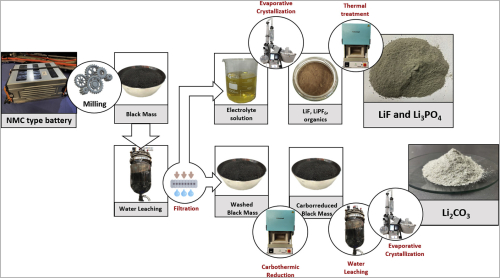Researchers from the Centro Nacional de Investigaciones Metalúrgicas (CENIM-CSIC) in Spain have developed a two-stage process for recovering lithium from black masses derived from NMC 622 electric vehicle (EV) batteries. This process is designed to be applied after the batteries undergo crushing and separation.
The first stage involves using hydrolysis to extract lithium compounds from the electrolyte degradation products (LiPF6). The resulting products from this stage are two industrially valuable compounds: lithium fluoride (LiF), commonly used in the production of lithium-ion battery electrolytes, and lithium phosphate (Li3PO4), which is utilized in lithium iron phosphate batteries.
In the second stage, a carbothermic reduction process is employed, in which various reducing agents are utilized. The outcome is a product that is leached with water and then crystallized through evaporation. According to the researchers, this stage successfully recovers lithium carbonate (Li2CO3) with a purity exceeding 98.4% and minimal LiF content, enabling the recovery of 90–94% of the total lithium present in the black mass.
The researchers published their findings in an open-access paper, ‘Recovery of lithium from spent NMC batteries through water leaching, carbothermic reduction, and evaporative crystallization process’, in the Journal of Power Sources. The authors of the paper are Lorena Alcaraz, Olga Rodríguez-Largo, Gorka Barquero-Carmona and Félix A López.


